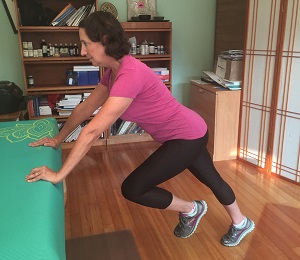If you’re like me, you remember having to participate in the yearly Presidential Physical Fitness Test back in your youth, which tested students in sit-ups as well as other exercises that tested strength, flexibility and endurance. The sit-up test was used to measure the strength and endurance of the abdominal muscles. For many years, sit-ups were seen as the golden ticket to stronger abs….and as a fitness-crazed teenager, I often did 500 sit ups a day! No doubt this likely contributed to my back pain and injuries as an adult! Although abdominal muscle strength is essential for back support, posture and stability, sit-ups are not only ineffective, but also can actually be detrimental to people with spinal injuries or osteoporosis. Sit ups only work one of the necessary muscles to maintain over abdominal strength and back health. Furthermore, the strong abdominal flexion movement that occurs when preforming a sit up can damage spinal ligaments, discs and vertebrates.
Thank goodness exercise has evolved to include safer and more effective ways to strengthen your abdominal muscles as well as all the muscles that are important in providing back support, posture, stability and balance, better known as your core muscles. Your core muscles are a group of muscles often described as a muscular box surrounding the spine: the abdominal muscles in front, the spinal and buttock muscles in the back, the hip and pelvic muscles below and the diaphragm at the top. The core muscles must all work together in order to protect the spine and provide stability with daily activities as well as when doing sports and recreational activities. Although strong core muscles are important for reducing risk of spinal injury in everyone, the added benefit of enhancing posture and balance makes maintaining strength in these muscles particularly important for women with osteoporosis.
One of my favorite exercises to strengthen the core muscles is abdominal planks. The plank not only activates the abdominal and lumbar spine muscles, but also the gluteal (buttock) and leg muscles as well as the muscles in the arms and shoulders. Activation of the abdominal and lumbar spine muscles are enhanced in exercises that also require simultaneous activation of the shoulders and glutes. Planks strengthen the core muscles through what is called an isometric contraction, a muscle contraction that does not result in movement. Although the muscles are contracting, the spine doesn’t move. Through isometric contraction, planks train the core muscles in the way they are supposed to work, allowing the muscles to provide stability, proper posture and correct spinal alignment. Movements that involve dynamic spinal flexion, such as a sit up, can increase risk for injury to spinal ligaments and discs as well as the risk for vertebral compression fractures in women with osteoporosis.
Even though planks are a great way to strengthen your core, it is essential to do them safely and correctly. In order to experience the benefits of performing planks without putting yourself at risk for injury, it’s first important to work toward creating a well-aligned plank pose.
Steps to performing and progressing a PLANK safely
- Learn to contract the core muscles while maintaining normal spine alignment:
- Bracing the stomach muscles co-activates the abdominals along with other deeper, internal core muscles. Think about tighten up your stomach as if you are protecting yourself against someone “punching you in the stomach!”
Try not to activate the muscles by pulling in or puffing out your stomach, just tighten them so no movement occurs in the spine.
- Bracing the stomach muscles co-activates the abdominals along with other deeper, internal core muscles. Think about tighten up your stomach as if you are protecting yourself against someone “punching you in the stomach!”
- Practice bracing your muscles and holding for 10 seconds 5 times several times a day to get the technique down prior to starting the exercises below.
- When performing the exercises below, focus on endurance of the core muscles first by holding the positions for up to 30 seconds and repeating 3-5 times.
- Once strength and stability can be maintained, challenge the core by adding arm and leg movements.
* It is important that you brace your stomach muscles prior to performing all exercises.
3 variations of the PLANK
Counter Plank: Great beginner plank pose and also good for people who can’t get down on their hands and knees.
- Make sure you are wearing shoes so your feet don’t slip!
- Place your hands on the counter, walk your feet back until your body is extended, your shoulders are in line with hands and your back is flat
- Gently brace your lower abdominal muscles without allowing your back to curl or arch and hold this position for 10-30 seconds and perform 3-5 times.
- As you get stronger you can alternate raising your knees to your chest as in a marching motion. March for 30 seconds and perform 3-5 times.
- While holding this position, you can also extend one of your legs behind you. Hold for 10 seconds and then switch and extend your other leg. Perform 5 times on each leg. Be sure not to lift the extend leg up so far that your back arch.



Quadruped Plank: You may want to start this exercise by first just alternately reaching the arms straight out in front, then alternate lifting the legs straight out to the back to build strength and stability before lifting the arm and leg together.
- When on your hands and knees, make sure your shoulders are lined up over your hands and your hips lined up over your knees.
- Brace your abdominal muscles and reach your right arm and left leg straight out in front and back. Hold 5 seconds. Perform 5 reaches to each side.
- Be sure not to lift your arm or leg up so high that your back arches.

Full Plank
- This exercise is done on your elbows placed in line with your shoulders.
- Walk your feet out to make a straight line your body, like a plank!
- Keep your back straight at all times and be sure not to allow your back to arch or bend.
- Brace your abdominal muscles and hold for 10-30 seconds, 3-5 times.
- Once you able to perform this exercise with good strength and form, you can try maintaining the plank position and alternately reaching one leg back at a time and holding for 5-10 seconds.

The most important thing with any exercise is to find YOUR appropriate starting level. I always recommend that you start with the basic exercises first to ensure proper abdominal bracing, alignment and form before gradually increasing to the more challenging positions.






